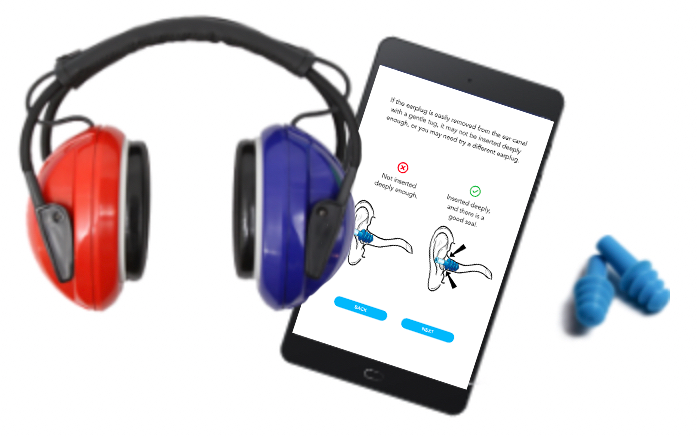Hearing Protector Fit Testing
with WAHTS
WAHTS offers a boothless, multi-person fit testing solution that is fast, user-friendly, and compliant with the ANSI S12.71 standard. The WAHTS hearing protector fit test is a psychophysical assessment that aligns with the ANSI/ASA S12.71-2018 standard for reporting Personalized Attenuation Ratings (PAR).
With its built-in audiometer, WAHTS provides the flexibility to conduct both hearing and fit testing, supporting individual or group-based hearing conservation programs.
With its built-in audiometer, WAHTS provides the flexibility to conduct both hearing and fit testing, supporting individual or group-based hearing conservation programs.

Speed
Performs a fit test in 4-6 minutes
Portability
Transport and use anywhere
Minimal Equipment
Uses the same equipment for hearing and fit testing
Ease-of-Use
Intuitive and easy software
Compatibility
Can be used across multiple HPDs
Multi-Person Testing
Performs multi-person hearing and fit testing
What is Hearing Protector
Fit Testing?
Fit testing quantitatively verifies that a hearing protector device (HPD) is functioning properly. It measures the effectiveness of HPDs and provides an individual’s Personal Attenuation Rating (PAR), which indicates the level of noise reduction achieved. This testing helps identify employees at risk due to poor fit and prevents further hearing degradation.
Improper insertion of hearing protection can lead to ineffective noise reduction and permanent hearing loss. The most effective hearing conservation programs incorporate hearing protector fit testing to ensure employee safety.
OSHA, NIOSH, and the U.S. DoD highlight fit testing as a best practice for hearing protection. Additionally, OSHA accepts fit testing as a proper method of training. The DoD has made it a requirement, and both OSHA and NIOSH recognize it as a best practice.
Improper insertion of hearing protection can lead to ineffective noise reduction and permanent hearing loss. The most effective hearing conservation programs incorporate hearing protector fit testing to ensure employee safety.
OSHA, NIOSH, and the U.S. DoD highlight fit testing as a best practice for hearing protection. Additionally, OSHA accepts fit testing as a proper method of training. The DoD has made it a requirement, and both OSHA and NIOSH recognize it as a best practice.

1. Launch
The administrator launches the WAHTS app to begin the fit test.
2. Training
The administrator will provide a quick training for the test takers on the task of responding to the stimuli.
3. Threshold Tasks
The test takers complete unoccluded (earplugs out) and occluded (ear plugs inserted) threshold measurements.
4. Reporting
Upon completion, the software reports attenuation at each frequency and an overall personal attenuation rating (PAR).

System Components
- Highly-attenuating headset allows you to
test in more environments - Intuitive tablet-based app provides hearing
protector education and calculates personal
protection - Ear plugs (not included)
- Supports both fit testing and automated
hearing testing

System Outputs
- PAR is computed with REAT-based method
- A report is available on the app and
can be downloaded by CSV, PDF - The results can be uploaded to a third-party
electronic health database
WAHTS
Fit Test Performance
OSHA, NIOSH, and the DoD all emphasize the importance of fit testing as a best practice for protecting employees' hearing. While OSHA doesn’t mandate fit testing for hearing protection devices, both the DoD and NIOSH recognize it as the gold standard.
In alignment with this, ANSI/ASA recently issued the ANSI S12.71-2018 standard, which outlines the laboratory-based procedures manufacturers must follow to validate their fit test systems. These validation studies ensure that fit test systems are both accurate and repeatable.
The following table provides the information required by the ANSI/ASA S12.71-2018 standard, which establishes performance criteria for systems estimating the attenuation of passive hearing protectors for individual users. This criteria is used to evaluate fit test systems that report personalized attenuation ratings (PAR)
In alignment with this, ANSI/ASA recently issued the ANSI S12.71-2018 standard, which outlines the laboratory-based procedures manufacturers must follow to validate their fit test systems. These validation studies ensure that fit test systems are both accurate and repeatable.
The following table provides the information required by the ANSI/ASA S12.71-2018 standard, which establishes performance criteria for systems estimating the attenuation of passive hearing protectors for individual users. This criteria is used to evaluate fit test systems that report personalized attenuation ratings (PAR)

